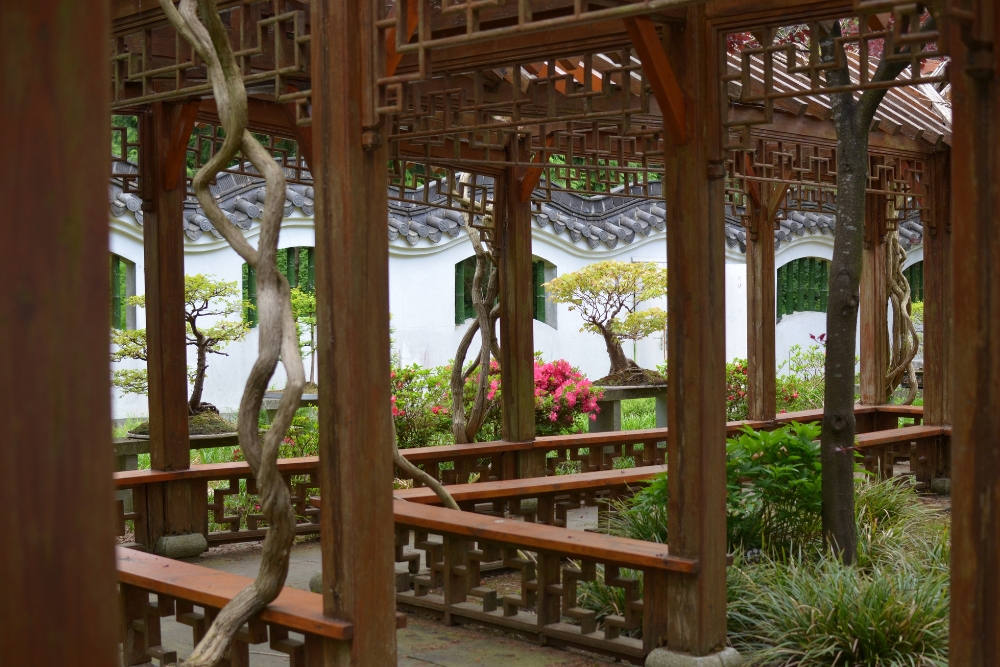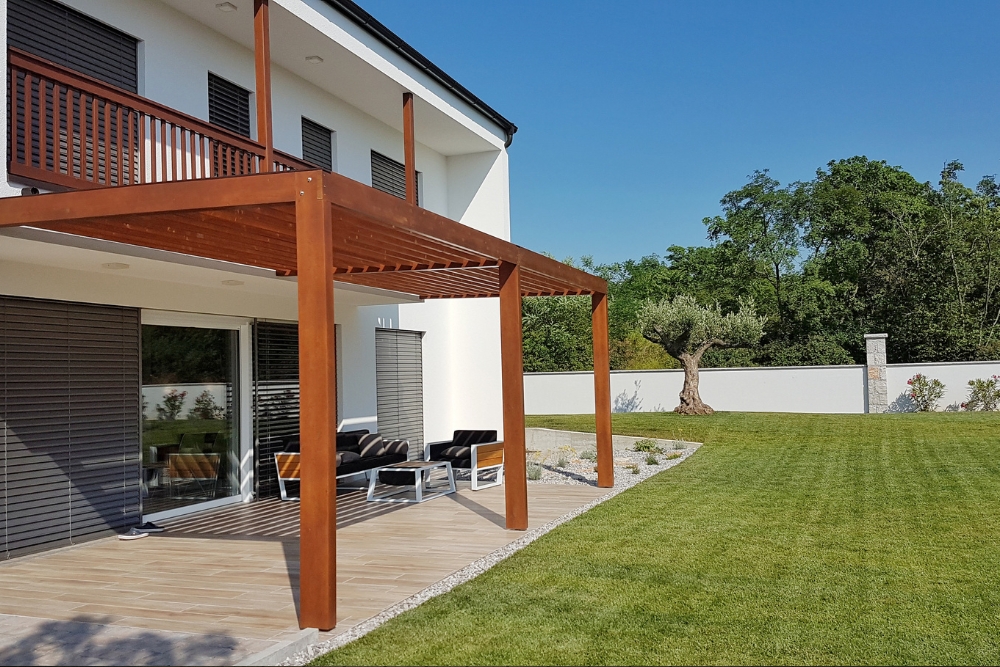Having a bit of a hard yakka trying to spruce up your garden’s wooden pergola? No worries, many of us have been down that garden path before. It turns out that good old timber frames come up as a treat when paired with the right kind of climbing plants.
We’ve put together this cracker of a guide to share our top picks for climbers that’ll turn your pergola into an enchanting green canopy. So, grab yourself a cuppa and get ready to be inspired by these ripper ideas blooming with potential!
Key Takeaways
- Climbing plants like honeysuckle, passion flowers, grapevines, and climbing roses are excellent choices for wooden pergolas, adding beauty and natural charm to outdoor spaces.
- Growing vines on wooden pergolas not only enhances the aesthetics of outdoor areas but also provides natural shade, increases oxygenation in the environment, and attracts beneficial pollinators like bees and butterflies.
- Wooden pergolas combined with climbing plants create a picturesque setting that complements the natural landscape while offering a cool retreat from the sun during warm Australian afternoons.
Best Climbing Plants for Pergolas
When it comes to choosing the best climbing plants for your pergola, there are a variety of options to consider. Honeysuckle, passion flowers, grapevines, and climbing roses are just a few examples of beautiful and vibrant plants that can add depth and colour to your outdoor space.
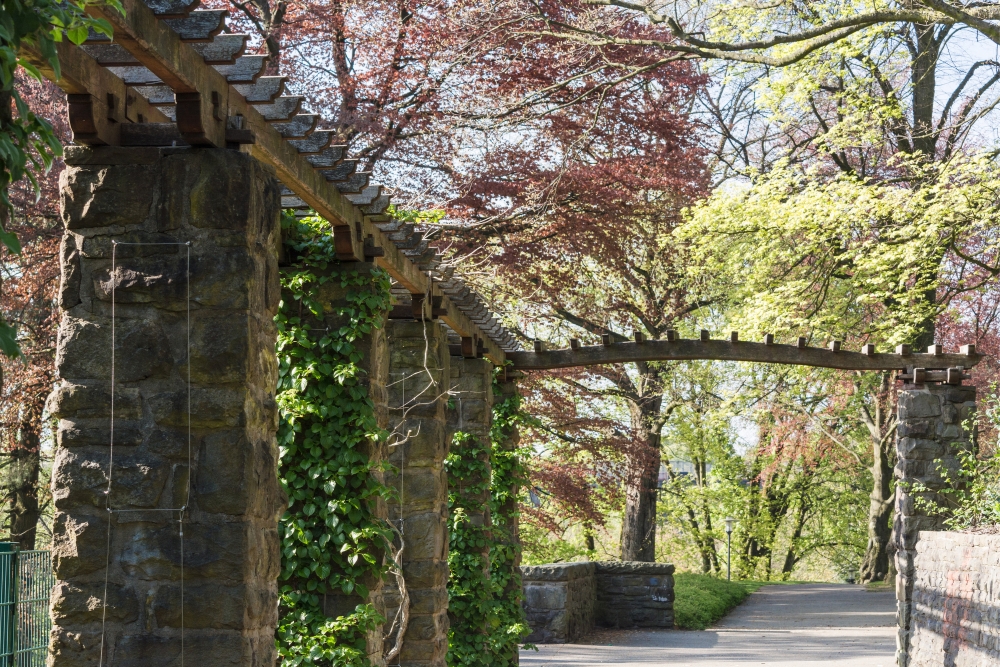
Honeysuckle
Honeysuckle vines are a real treat for any wooden pergola. Their sweet fragrance and tubular flowers add a sensory delight to outdoor living spaces. In the spring and summer, honeysuckle blooms profusely, attracting hummingbirds and butterflies which can turn your garden into a nature sanctuary.
The rapid growth of these plants means you’ll have lush greenery in no time, making them excellent for creating natural shade on those warm Australian afternoons.
We love the versatility of honeysuckle because it’s not just about looks; this hardy climber is also quite resilient against pests and diseases. It can climb up your timber pergolas with ease, its twining vines wrapping around latticework or trellis without much help from us.
So as you sit back in your rose garden or stroll along the shaded passageways under your blooming arbor, the inviting scent of honeysuckle will make every moment outdoors more enjoyable.
Plus, they’re not complicated to maintain – regular pruning keeps them thriving year-round while enhancing the overall look of our timber structures designed specifically for climbing plants like these.
Passion Flowers
When considering climbing plants for your wooden pergola, passion flowers are an excellent choice due to their stunning and exotic appearance. These vibrant blooms not only add a pop of colour to your outdoor space but also attract pollinators like bees and butterflies.
The unique and intricate structure of passion flowers can provide visual interest to the vertical posts or pillars of your pergola, creating a captivating natural display.
Passion flowers thrive in warm climates and require well-drained soil with adequate sunlight, making them ideal for Australian pergolas. With proper care and maintenance, these resilient vines can beautify your wooden pergola while blending harmoniously with nature.
Potato Vine
Potato vine is an excellent choice for wooden pergolas due to its vigorous growth and ability to provide ample coverage. Its attractive foliage and delicate flowers add a touch of elegance to outdoor spaces, making it a popular option for homeowners looking to enhance the aesthetics of their pergolas.
This fast-growing vine thrives in sunny locations and can tolerate various soil types, making it a versatile and low-maintenance addition to your pergola. With its resilience and ornamental appeal, potato vine is a top contender for creating lush greenery on your timber pergola.
Moving on from the benefits of using potato vines, let’s delve into another equally stunning climbing plant that can flourish on wooden pergolas – Clematis.
Grapevines
Now, let’s move from potato vines to another excellent choice for wooden pergolas: grapevines. When considering climbing plants for a timber pergola, which provides practicality and aesthetic appeal, grapevines stand out as an ideal option.
These versatile vines not only create a beautiful natural canopy but also offer delicious fruits if you choose fruit-bearing varieties like Concord or Thompson Seedless. Additionally, the dense foliage of grapevines provides ample shade during warmer months while adding a touch of rustic charm to your outdoor space.
Moreover, these hardy vines are well-suited to the Australian climate and can thrive in various soil types, making them an attractive and low-maintenance choice for adorning your wooden pergola.
Clematis
After considering the robust nature of grapevines, let’s now turn our attention to clematis. This climbing perennial vine, with its fragrant flowers and vibrant colours, is an ideal choice for adding visual interest to your wooden pergola.
Clematis can thrive in Australian pergolas, especially when providing support for these delightful vines.
Clematis blooms in a variety of shades and shapes, adding a touch of elegance and charm to any outdoor space. Whether you opt for the stunning blues and purples of ‘The President’ or the delicate whites and pinks of ‘Nelly Moser,’ Clematis provides an array of options for homeowners looking to enhance the aesthetic appeal of their pergolas.
Climbing and Rambling Roses
After considering the best climbing plants for your pergola, it’s essential to explore the timeless beauty of climbing and rambling roses. These classic flowering vines not only add an enchanting aesthetic to your outdoor space but also infuse a sweet fragrance into the air.
Climbing roses are perfect for adorning wooden pergolas, blending seamlessly with their natural surroundings.
When choosing climbing and rambling roses for your wooden pergola, consider varieties such as “Crimson Glory” or “Morning Glories.” These flowers will provide a burst of colour and fill your outdoor area with delightful scents.
Wisteria
Wisteria is an exquisite choice for adorning wooden pergolas, as its cascading purple or white blooms create a striking visual impact. This vigorous climber thrives in the Australian climate, producing abundant flowers in spring and early summer.
With its durable woody vines and vigorous growth habit, wisteria can quickly cover the structure of a pergola, providing shade and adding a touch of natural elegance to outdoor spaces.
The fragrant blossoms of wisteria also attract beneficial pollinators such as bees and butterflies, enhancing the biodiversity of your garden while beautifying your pergola.
Trumpet Vine
Trumpet vine, also known as Campsis radicans, is a vigorous and fast-growing woody vine that produces large, trumpet-shaped flowers in vibrant shades of red, orange, or yellow. This hardy perennial thrives in various climatic conditions and can quickly cover wooden pergolas with its lush foliage and showy blossoms.
The trumpet vine is well-suited for Australian pergolas due to its adaptability to different soil types and sun exposure. Its stunning blooms attract hummingbirds and other pollinators, adding an extra touch of natural beauty to your outdoor space.
With proper care and maintenance, this climbing plant can transform your wooden pergola into a picturesque haven.
Crimson Glory Vine
After discussing the beautiful trumpet vine, let’s consider the striking Crimson Glory Vine. This vigorous climber features large, velvety deep red flowers that add a dramatic touch to your pergola.
The plant is hardy and requires minimal maintenance, making it an excellent choice for homeowners seeking vibrant colour without excessive upkeep. With its ability to cover large areas and thrive in warm climates, this stunning vine will transform your wooden pergola into a captivating focal point in your outdoor space.
The Crimson Glory Vine can bring an abundance of beauty and charm to your pergola with its radiant blooms and lush foliage. Its resilience and low-maintenance nature make it an ideal addition for adding drama and vibrancy to your outdoor living area effortlessly.
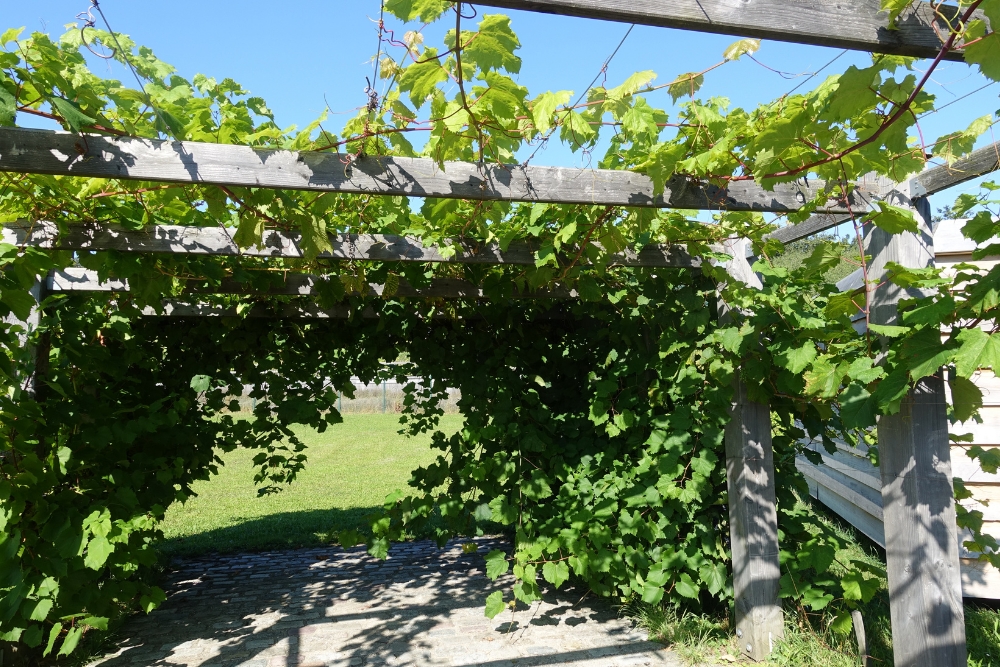
Benefits of Growing Vines on Your Pergola
Growing vines on your pergola not only enhances the overall aesthetics of your outdoor space but also provides much-needed shade during the hot summer days. Additionally, it helps increase oxygenation in the surrounding area and attracts pollinators, contributing to a healthier garden ecosystem.
Enhances aesthetics
Climbing plants on wooden pergolas create a stunning visual display, enhancing the overall aesthetics of your outdoor space. The intertwining vines and blossoming flowers add a touch of natural beauty to the structure, seamlessly blending it with its surroundings.
As the climbing roses and vines grow and spread across the pergola, they infuse charm and character into your backyard or patio area.
Wooden pergolas provide an ideal backdrop for showcasing the vibrant foliage and blooms of climbing plants. The combination of timber structures with lush greenery creates a picturesque setting that complements the natural landscape while adding a quaint allure to your outdoor living space.
Provides shade
Wooden pergolas with climbing plants provide natural shade, making them an ideal addition to any outdoor space. The timber structure combined with the lush foliage of climbing roses or vines creates a cool and refreshing retreat from the harsh sun.
This makes it perfect for enjoying a cup of coffee in the morning or hosting outdoor gatherings during hot summer days. Additionally, wooden pergolas covered in climbing plants can help reduce cooling costs by lowering the temperature around your home, creating a comfortable environment that integrates seamlessly with nature.
Increases oxygenation
Climbing plants on your pergola can increase oxygenation in your outdoor space. Vines such as grapevines, wisteria, and passion flowers release oxygen during photosynthesis, contributing to improved air quality.
This natural process not only benefits the environment but also creates a more refreshing atmosphere for you to enjoy in your outdoor living area. As climbing plants flourish and grow on your wooden pergola, they help to enhance the overall oxygen levels around your home.
Wooden pergolas provide an ideal structure for growing climbing plants that naturally contribute to increased oxygen levels in the surrounding environment. The next section will discuss how these vines can attract pollinators to your outdoor space, further enhancing its natural beauty and charm.
Attracts pollinators
Climbing plants on wooden pergolas attract pollinators like bees and butterflies, enhancing the natural ecosystem of your outdoor space. These pollinators play a crucial role in plant reproduction, ensuring the blooming of flowers and the production of fruits.
By providing a habitat for these beneficial insects, you contribute to the health and vitality of your garden while enjoying the beauty of flowering vines intertwined with your pergola.
To further maximise the benefits of having climbing plants that attract pollinators on your wooden pergola, it is essential to choose varieties that are native to your area and provide nectar throughout different seasons.
This ensures a consistent food source for these important insects. Creating a welcoming environment for pollinators not only adds vibrancy to your outdoor space but also supports biodiversity in your local ecosystem.
Important Considerations for Growing Pergola Plants
When choosing climbing plants for your pergola, it’s important to consider the climatic conditions in your area and select plants that are suitable for the environment. Additionally, the structure of your pergola should be sturdy enough to support the weight of climbing vines, and regular maintenance is essential to keep them healthy and thriving.
Climatic conditions
Wooden pergolas with climbing plants are best suited to temperate climates that experience moderate rainfall and sunlight. Climbing roses and vines thrive in regions with warm, sunny summers and mild winters, making them ideal for Australian pergolas.
These climbing plants require well-drained soil and moderate watering, which is conducive to areas with a Mediterranean climate. Choosing suitable vines for your wooden pergola depends on the local weather patterns, ensuring they can withstand seasonal changes while enhancing the structure’s aesthetics.
When considering the climatic conditions for growing climbing plants on your pergola, it’s important to understand how temperature and precipitation levels impact their growth and overall health.
Pergola structure
When considering the structure of your pergola, it’s important to choose durable and sturdy materials like timber uprights with crossbeams and laterals at the top. Ensure that the design allows for enough space between the beams to accommodate climbing plants.
Additionally, consider using vinyl pergolas as a base for climbing plants, but be sure to select ones that can support the weight of vines such as wisteria, grapevines, or climbing roses.
Proper installation is crucial for stability and safety, so take care in constructing your pergola to ensure it can withstand the weight of mature vines and provide adequate support.
Plant maintenance
To maintain the health and appearance of your climbing plants on the pergola, regular maintenance is essential. Prune your vines to remove dead or damaged growth, ensuring good air circulation and preventing diseases.
Clean the structure by removing debris and any invasive plants that may compete with your climbing roses or vines for nutrients. Regularly inspect the timber for signs of wear or rot to ensure longevity and structural integrity.
Keep an eye out for pests such as aphids or spider mites, which can damage leaves and affect plant health, addressing them promptly with appropriate measures.
Taking care of climbing plants on a wooden pergola guarantees their lush growth and enhances the beauty of your outdoor space. Regular pruning, cleaning, inspection, and pest control are simple tasks that keep your pergola thriving with vibrant climbing roses and vines.
Potential issues
When growing climbing plants on a wooden pergola, it is important to anticipate potential issues. One common issue is that some vines can grow aggressively and may damage the pergola structure if not properly maintained.
Another issue to consider is that certain climbing plants are prone to pests and diseases, which can spread to other garden areas if not managed carefully. Additionally, choosing the right climbing plant for the local climate and ensuring proper installation and support are essential in preventing structural damage over time.
It’s worth noting that regular maintenance and pruning will help mitigate these issues, ensuring the healthy growth of your climbing plants while preserving the integrity of your wooden pergola.
Alternatives to Growing Plants on Pergolas
Instead of growing plants on pergolas, you can explore using wall-mounted supports, vertical gardens, or planting in containers to add greenery and colour to your outdoor space. Interested to find out more about these alternatives? Keep reading!
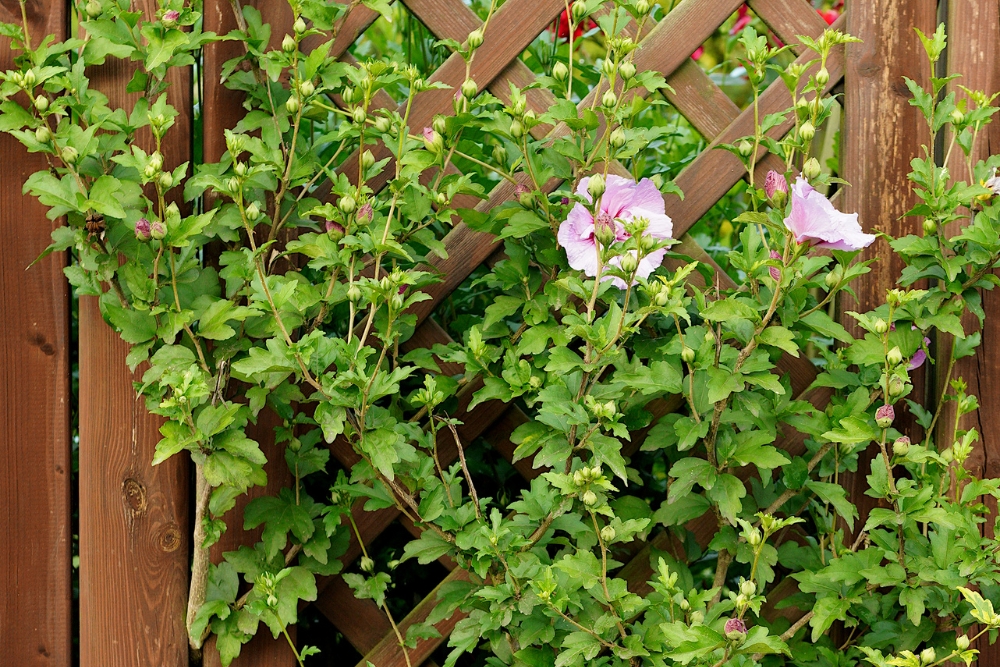
Using wall-mounted supports
When designing your pergola, consider using wall-mounted supports for climbing plants. Wall-mounted supports provide a sturdy structure for the vines to grow on, creating a lush green backdrop against your outdoor walls.
These supports can also help maximise space in smaller outdoor areas, allowing you to enjoy the beauty of climbing plants without sacrificing ground space.
By utilising wall-mounted supports, you can expand your options for planting climbing roses and vines around your property. This method is especially beneficial if you have limited ground space or want to create a seamless transition between indoor and outdoor spaces.
Vertical gardens
Wooden pergolas can also serve as a support structure for vertical gardens, offering an alternative option to growing climbing plants. By attaching planter boxes or trellises to the sides of the pergola, you can create a lush and green wall of foliage.
Vertical gardens not only enhance the aesthetics of your outdoor space but also maximise limited area by utilising vertical surfaces. Incorporating hanging baskets and wall-mounted planters with trailing vines and cascading flowers adds depth and colour to your wooden pergola, transforming it into a living, breathing sanctuary.
These innovative gardening solutions provide an opportunity to explore diverse plant species that thrive in small spaces, such as ferns, succulents, herbs, and compact flowering plants.
Planting in containers
If a wooden pergola isn’t the right fit for your outdoor space, consider planting climbing plants in containers. Containers offer flexibility and allow you to move your plants as needed to maximise sunlight or create different visual effects.
You can use large pots or even repurpose items such as barrels or buckets as long as they have proper drainage. When choosing containers, keep in mind that larger pots hold more soil and moisture, typically requiring less frequent watering than smaller ones.
Remember that many climbing plants need sturdy support structures; ensure your containers can accommodate trellises or stakes for the vines to climb on. Additionally, placing containers strategically around your outdoor area can add depth and drama while creating inviting focal points.
How to Build and Maintain a Pergola with Climbing Plants
Choosing the right materials for your wooden pergola is crucial in ensuring its durability and longevity. Proper installation, training and pruning techniques are essential to keep your climbing plants healthy and thriving throughout the seasons.
Regular seasonal care and maintenance will help sustain the beauty of your pergola with climbing roses and vines.
Choosing the right materials
Wooden pergolas can be built using a variety of materials, but timber is an ideal choice due to its natural aesthetic and durability. When selecting the wood for your pergola, consider using naturally resistant timbers like cedar or redwood to ensure longevity without the need for chemical treatments.
These timbers are also known for their ability to withstand outdoor elements, making them suitable for supporting climbing roses and vines. Additionally, treated pine is a cost-effective option that offers good durability when properly maintained.
It’s important to choose materials that complement the overall look of your outdoor space while withstanding weather conditions. Timber uprights with crossbeams and laterals provide sturdy support for climbing plants such as wisteria and grapevines.
Proper installation
To properly install a wooden pergola for climbing roses and vines, begin by choosing the right spot in your outdoor space. Ensure that it receives adequate sunlight and consider factors such as soil drainage and accessibility for maintenance.
When constructing the pergola, use durable timber uprights and crossbeams for longevity. Make sure to secure the structure firmly into the ground to withstand the weight of climbing plants over time.
Additionally, be mindful when anchoring supports for vines to encourage healthy growth without causing damage to the pergola.
Once your pergola is in place, carefully train young stems of climbing plants along its framework using twine or soft ties. Provide regular pruning to maintain their shape and prevent overcrowding on the structure while promoting healthy growth.
Training and pruning techniques
Proper installation ensures the pergola is ready to support climbing plants, but ensuring they grow and flourish as desired requires proper training and pruning techniques. Regularly train new growth along the pergola structure to encourage it to spread evenly.
As the plants mature, selectively prune them to maintain a balanced appearance and promote healthy growth. Pruning also helps manage excessive foliage and encourages better air circulation, reducing the risk of disease.
Careful training and pruning are essential for maintaining an attractive wooden pergola adorned with climbing roses or vines. It’s important to understand each plant’s specific needs in terms of training and pruning frequency to ensure they thrive without overwhelming the structure.
Seasonal care and maintenance
When caring for climbing plants on your wooden pergola, regular maintenance is essential year-round. In the spring and summer months, it’s important to water the plants regularly while also ensuring that they receive adequate sunlight.
Regular pruning of overgrown or dead branches is necessary to maintain the health and appearance of your climbing roses and vines.
During autumn and winter, it’s crucial to protect your plants from harsh weather conditions such as frost. Consider adding a protective layer of mulch around the base of the plants to insulate their roots.
Additionally, check for any signs of disease or pests regularly throughout all seasons and take appropriate measures promptly if needed.
By consistently tending to seasonal care and maintenance tasks, your wooden pergola can continue to support healthy and vibrant climbing plants throughout the year.
Enhance Your Space with Aluminium Pergolas!
Creating a beautiful outdoor space with wooden pergolas and climbing plants enhances the overall aesthetic appeal. Growing vines on pergolas not only provides shade but also attracts pollinators, contributing to a healthier environment.
Carefully selecting the right climbing plants and maintaining them properly can transform your pergola into a stunning focal point in your landscape. With the right approach, wooden pergolas offer an ideal structure for showcasing the natural beauty of climbing roses and vines.
Embrace the romance of nature with our Wooden Pergolas designed for climbing roses and vines! At Aluminium Pergolas, we bring you the perfect blend of structural elegance and natural beauty. Imagine your outdoor space adorned with lush greenery and blooming flowers, creating a picturesque retreat. Our Wooden Pergolas provide the ideal framework for climbing roses and vines, enhancing your garden with timeless allure. Elevate your outdoor experience – bring the charm of nature into your space with Aluminium Pergolas. Contact us now to transform your garden into a blooming haven!

